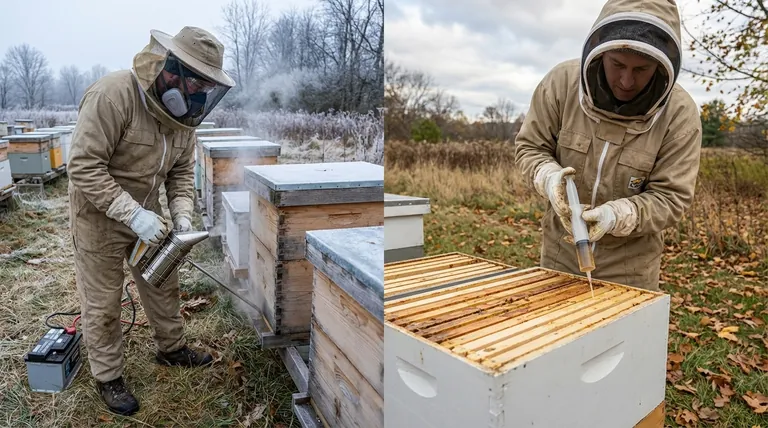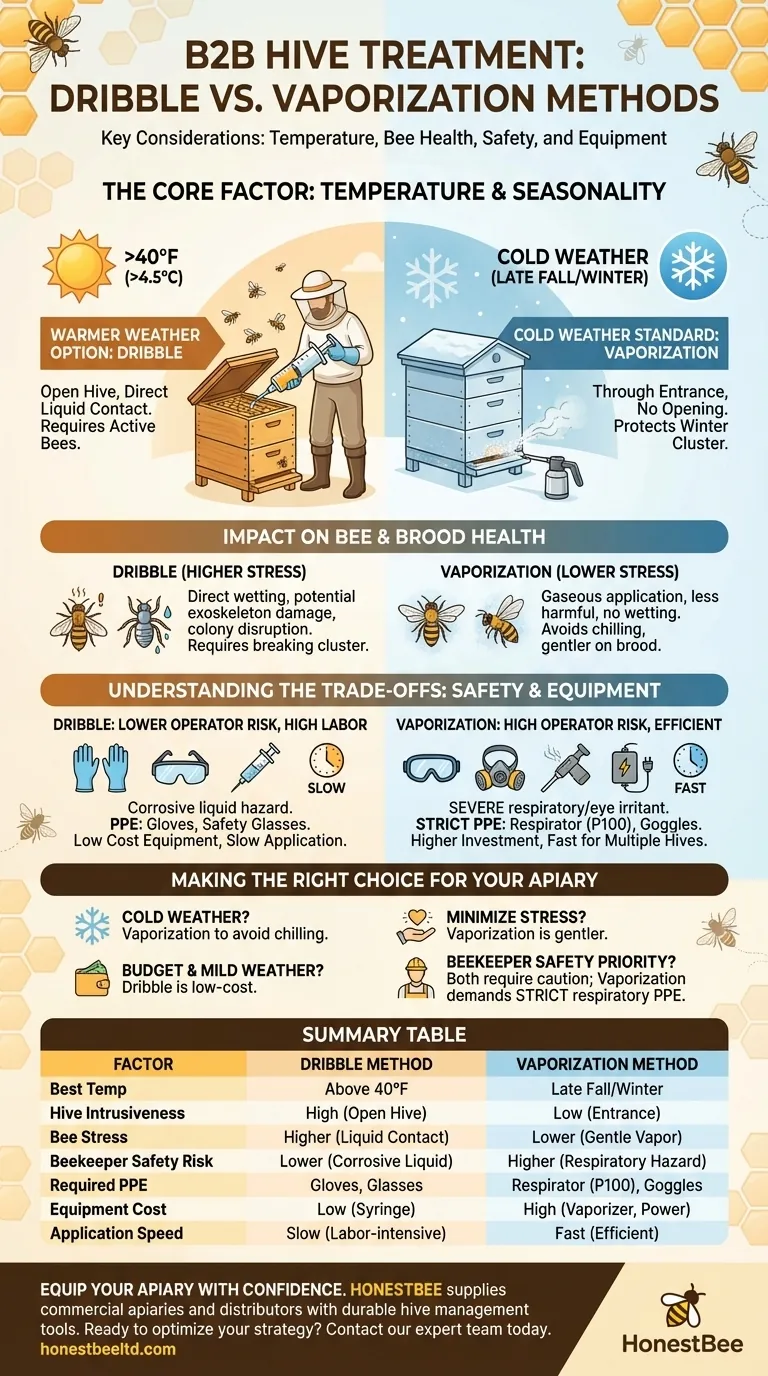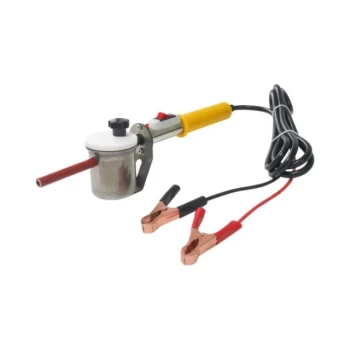Ultimately, the choice between dribble and vaporization methods for hive treatment hinges on external temperature, the state of the bee cluster, and beekeeper safety protocols. Vaporization is the preferred method for cold weather as it does not require opening the hive, while the dribble method is a simpler, low-cost option suitable only for milder conditions when the hive can be opened without causing undue stress.
Your decision is a trade-off between hive intrusiveness and personal safety risk. Vaporization is less invasive for the bees but requires stringent personal protective equipment for the beekeeper, whereas the dribble method is more disruptive to the colony but poses a lower acute risk to the operator.

The Core Factor: Temperature and Seasonality
The most significant variable influencing your choice is the ambient temperature and the corresponding state of the bee colony. This directly impacts both the effectiveness of the treatment and the health of your bees.
Vaporization: The Cold Weather Standard
Vaporization is the superior method for treating hives in late fall and winter. This is because the treatment can be applied through the hive entrance without opening the lid.
This process avoids breaking the hive's propolis seals and releasing stored heat. It protects the tightly-formed winter cluster from a sudden, life-threatening drop in temperature, making it the safest option for the bees in cold weather.
Dribble: A Warmer Weather Option
The dribble method requires opening the hive to trickle an oxalic acid solution directly onto the bees between the frames. This is only feasible in warmer temperatures, typically above 40°F (4.5°C).
Opening the hive in cold weather can cause severe thermal shock and stress the colony. Furthermore, the bees must be active enough to move around and spread the liquid treatment throughout the cluster, which is not possible when they are in a tight winter huddle.
Impact on Bee and Brood Health
Beyond temperature, the two methods differ significantly in how they affect the bees themselves. While both are effective when used correctly, their delivery mechanisms have different consequences.
Why Vaporization is Generally Safer for Bees
The reference material correctly notes that vaporization is often less harmful. The fine vapor coats the bees and hive surfaces without directly wetting them.
This gaseous application is less stressful and avoids the risk of chilling individual bees, which can happen with a liquid dribble, especially if temperatures drop unexpectedly after treatment. It is also considered gentler if any brood is accidentally present.
The Risks of the Dribble Method
The dribble method is inherently more disruptive. It involves directly wetting the bees with an acidic sugar solution, which can damage their exoskeletons and cause mortality.
Breaking the winter cluster to apply the dribble is a major stressor. If the colony cannot re-cluster quickly and effectively, it can lead to significant bee loss.
Understanding the Trade-offs: Safety and Equipment
Your decision also involves practical considerations regarding equipment, speed, and, most importantly, your personal safety.
Beekeeper Safety: The Vapor Hazard
This is a critical point. Vaporized oxalic acid is a severe respiratory and eye irritant. Using a vaporizer requires, at a minimum, a properly-fitted respirator with acid gas cartridges (P100 rating) and full-seal safety goggles.
Failure to use appropriate personal protective equipment (PPE) can lead to significant and lasting lung damage. While vaporization is quick and efficient per hive, the safety protocol is non-negotiable.
Beekeeper Safety: The Dribble Method
The dribble method poses a lower respiratory risk but is not without its own hazards. The oxalic acid solution is corrosive.
You must wear nitrile gloves and safety glasses to prevent the solution from contacting your skin or eyes. While less acutely dangerous than the vapor, direct contact can still cause chemical burns.
Equipment and Application Speed
Vaporization requires a specialized tool—an oxalic acid vaporizer—and a power source, representing a higher initial investment. However, once set up, treating multiple hives is extremely fast.
The dribble method requires only a large syringe, making it very low-cost. However, the process of opening each hive, frame by frame, is significantly more time-consuming and labor-intensive.
Making the Right Choice for Your Hive
Choose the method that best aligns with the specific conditions of your apiary and your priorities as a beekeeper.
- If you are treating in cold weather (late fall/winter): Vaporization is the only responsible choice to avoid chilling the colony.
- If your primary focus is minimizing stress on the bees: Vaporization is gentler, as it avoids direct liquid contact and does not require breaking the cluster.
- If your budget is the main constraint and you are treating in mild weather: The low-cost dribble method can be effective, provided you understand and accept the higher disruption to the hive.
- If you prioritize beekeeper safety above all: Both methods require caution, but vaporization demands a strict and non-negotiable commitment to using a high-quality respirator and eye protection.
Aligning your treatment method with the season and hive conditions is the cornerstone of effective and responsible beekeeping.
Summary Table:
| Factor | Dribble Method | Vaporization Method |
|---|---|---|
| Best Temperature | Above 40°F (4.5°C) | Late fall & winter (cold weather) |
| Hive Intrusiveness | High (requires opening hive) | Low (applied through entrance) |
| Bee Stress | Higher (direct liquid contact) | Lower (gentle vapor) |
| Beekeeper Safety Risk | Lower (corrosive liquid) | Higher (respiratory vapor hazard) |
| Required PPE | Gloves, safety glasses | Respirator (P100), safety goggles |
| Equipment Cost | Low (syringe) | High (vaporizer, power source) |
| Application Speed | Slow (labor-intensive) | Fast (efficient for multiple hives) |
Equip Your Apiary with Confidence
Choosing the right treatment method is just the first step. Having reliable, high-quality equipment is essential for the health of your bees and your own safety.
HONESTBEE supplies commercial apiaries and beekeeping equipment distributors with the durable, wholesale-focused supplies needed for effective hive management. Whether you require precise dribble applicators or robust vaporization systems, we provide the tools for successful, responsible beekeeping.
Ready to optimize your varroa treatment strategy? Contact our expert team today to discuss the best equipment solutions for your operation's specific needs and scale.
Visual Guide

Related Products
- Oxalic Acid Vaporizer 12V for Bee Varroa Mite Treatment
- Durable 12V Oxalic Acid Vaporizer for Varroa Mite Treatment Beehive Beekeeping Tool
- Heavy Duty 12V Oxalic Acid Evaporator Vaporizer for Bee Varroa Mite Treatment Beekeeping Fumigator Atomizer
- 12V Bee Mite Removal Evaporator Oxalic Acid Vaporizer for Bee Fumigation Treatment 180W Atomization
- Adjustable Formic and Acetic Acid Dispenser for Bee Mite Treatment
People Also Ask
- What should be inserted under the hive to reduce drafts during oxalic acid vaporization? Ensure Effective Varroa Mite Control
- What safety precautions should be taken when using oxalic acid for vaporization? Protect Yourself and Your Bees
- What should be done after applying the vapor? A Step-by-Step Guide to Sealing Your Hive
- How is the oxalic acid solution prepared for vaporization? No Solution Needed—Use Dry Crystals for Varroa Control
- What are the methods for applying oxalic acid in beekeeping? Control Varroa Mites Effectively



















